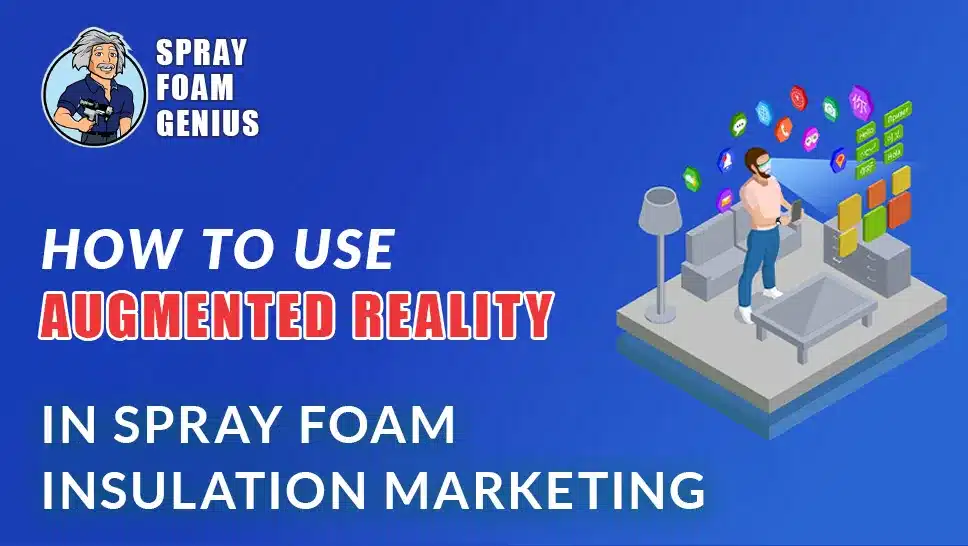
In an era where digital transformation is reshaping industries, incorporating Augmented Reality (AR) into your spray foam insulation marketing strategy can provide a significant competitive edge. AR enhances how potential clients experience your services, making your marketing efforts more interactive and engaging. This guide will delve into how AR can revolutionize your spray foam insulation marketing, offering practical tips and strategies to help you implement this cutting-edge technology effectively.
What is Augmented Reality?
Understanding Augmented Reality
Augmented Reality (AR) overlays digital information—such as images, videos, and data—onto the real world through devices like smartphones, tablets, or AR glasses. Unlike Virtual Reality (VR), which immerses users in a completely digital environment, AR enhances their real-world view with additional virtual elements. This interactive technology allows users to engage with digital content in a way that feels integrated with their surroundings.
How AR Differs from Virtual Reality
- Augmented Reality (AR): Adds digital elements to a live view of the physical world. Users can interact with both real and virtual elements simultaneously.
- Virtual Reality (VR): Creates a completely immersive digital environment, often requiring specialized equipment like VR headsets.
Why Augmented Reality Matters for Spray Foam Insulation Marketing
Enhanced Visualization
AR enables potential customers to visualize how spray foam insulation will look and perform in their own spaces. By providing a virtual simulation, clients can better understand the benefits of insulation, such as improved energy efficiency and comfort, before making a decision.
Interactive Experience
Interactive elements, such as virtual tours or product demonstrations, can engage clients more effectively than traditional marketing materials. AR allows users to interact with digital content, leading to a deeper understanding of your services and a stronger emotional connection.
Competitive Edge
Incorporating AR into your marketing strategy can set you apart from competitors who rely on conventional methods. Demonstrating a willingness to embrace new technologies not only showcases your innovative approach but also helps position your business as a leader in the industry.
Improved Customer Engagement
AR provides an immersive experience that captures and retains customer interest. By offering engaging and interactive content, you increase the likelihood of converting leads into customers and fostering long-term relationships.
Implementing Augmented Reality in Your Marketing Strategy
1. Create an AR-Enhanced Website
Your website is often the first point of contact with potential clients. Enhancing it with AR features can provide a unique and engaging experience. Consider the following options:
Interactive Product Demonstrations
- 3D Models: Allow visitors to interact with 3D models of spray foam insulation. They can explore the insulation process, view different types of insulation, and understand their benefits in a virtual environment.
- Before-and-After Simulations: Show potential clients how their spaces will look before and after applying spray foam insulation. This can help them visualize the impact and effectiveness of your services.
Virtual Tours
- Project Showcases: Offer virtual tours of completed projects where your insulation was applied. This can include a 360-degree view of different areas of the property, highlighting the insulation’s coverage and effectiveness.
- Interactive Maps: Create interactive maps of properties with different insulation solutions applied. Users can click on various areas to see detailed information and visualizations.
Cost Estimation Tools
- Interactive Calculators: Implement AR tools that help users estimate the cost of insulation based on their property size and requirements. They can input details and receive an instant estimate, enhancing their understanding of potential costs.
2. Develop AR Mobile Apps
A dedicated AR mobile app can provide a personalized and interactive experience for your clients. Here’s how you can use an AR app to benefit your business:
Visualize Insulation Projects
- Augmented Reality Visualization: Allow users to take photos of their space and overlay different types of insulation options. They can see how various materials would look in their environment, helping them make informed decisions.
- Customization Options: Offer customization features where users can choose different insulation styles and see how they fit into their space.
Showcase Before-and-After Scenarios
- Transformation Visualizations: Use AR to display the transformation of spaces before and after applying spray foam insulation. This can be an effective way to demonstrate the benefits and impact of your services.
- Dynamic Comparisons: Provide dynamic comparisons of different insulation types and their effects on energy efficiency, comfort, and aesthetics.
Interactive Learning
- Educational Content: Include AR-enhanced tutorials and how-to guides within the app. Users can access step-by-step processes and interactive explanations of insulation techniques, helping them understand the installation process and benefits.
- Expert Tips: Offer expert tips and advice through AR experiences, providing valuable insights into insulation best practices and maintenance.
3. Leverage AR in Social Media Campaigns
Social media platforms are an excellent venue for showcasing your AR capabilities and engaging with your audience. Here’s how you can incorporate AR into your social media strategy:
AR Filters and Effects
- Custom Filters: Create AR filters related to spray foam insulation that users can apply to their photos. For example, an effect that shows a virtual layer of insulation on their walls can be both entertaining and informative.
- Interactive Stickers: Use AR stickers that provide information about insulation benefits or promotions when users scan them with their smartphones.
Interactive Ads
- AR Ads: Use AR in your social media ads to create interactive experiences. For instance, an ad could allow users to see how insulation would look in their home through their smartphone camera, making the ad more engaging.
- Product Demonstrations: Showcase how your insulation products work through interactive AR ads that provide a virtual demonstration of their application and benefits.
Live Demonstrations
- AR Live Sessions: Host live sessions on platforms like Facebook or Instagram where you use AR to demonstrate insulation techniques or showcase completed projects. This real-time interaction can drive engagement and generate leads.
- Q&A Sessions: Use AR during live Q&A sessions to address client questions and provide visual explanations of insulation processes and benefits.
4. Enhance In-Person Presentations
AR can also enhance your face-to-face interactions with clients. Here’s how to integrate AR into your in-person presentations:
Interactive Sales Brochures
- AR Brochures: Provide AR-enabled brochures that clients can scan with their smartphones to access additional content. This could include videos, 3D models, or virtual simulations of insulation projects.
- Supplementary Information: Use AR to offer supplementary information, such as detailed explanations of insulation materials and their benefits, directly from the brochure.
Augmented Presentations
- Interactive Models: Use AR during presentations to display interactive models of insulation solutions. Clients can interact with these models to better understand complex concepts and visualize the impact of your services.
- Real-Time Comparisons: Show real-time comparisons of different insulation types and their effects on energy efficiency and comfort through AR presentations.
On-Site AR Demonstrations
- Property-Specific AR: If you’re meeting clients at their property, use AR to show them how insulation will look and perform in their specific space. This personalized approach can help address concerns and provide tailored solutions.
- Immediate Visualization: Offer immediate visualization of insulation options and their benefits, allowing clients to make informed decisions on the spot.
Best Practices for Implementing AR in Your Marketing Strategy

Focus on User Experience
- Usability: Ensure that your AR content is user-friendly and adds value to the customer experience. Test your AR applications thoroughly to ensure they are intuitive and functional.
- Performance: Optimize the performance of your AR features to ensure smooth and seamless interactions. Avoid lag and technical issues that could detract from the user experience.
Integrate with Other Marketing Efforts
- Holistic Approach: Combine AR with other marketing strategies, such as SEO, content marketing, and social media, to create a cohesive and comprehensive approach. This integration can enhance your overall marketing effectiveness.
- Cross-Promotion: Promote your AR features across different marketing channels to maximize visibility and engagement. Use email campaigns, social media posts, and website content to highlight your AR capabilities.
Educate Your Team
- Training: Provide training and resources to help your team understand and leverage AR technology effectively. Ensure they are equipped to use AR in client interactions and marketing efforts.
- Best Practices: Share best practices and success stories related to AR implementation to inspire and guide your team.
Monitor and Measure Results
- Analytics: Track the performance of your AR initiatives using analytics tools. Measure metrics such as engagement, lead generation, and conversion rates to assess the impact of your AR strategies.
- Continuous Improvement: Use data-driven insights to refine your AR approach and make informed decisions. Continuously evaluate and adjust your strategies to optimize results.
Ready to Revolutionize Your Marketing Strategy?
Augmented Reality offers a unique opportunity to enhance your spray foam insulation marketing efforts, providing interactive and engaging experiences that can set you apart from the competition. By incorporating AR into your website, mobile apps, social media campaigns, and in-person presentations, you can attract new clients and showcase your innovative approach.
Are you ready to take your marketing to the next level with AR? Contact us today to learn more about how Spray Foam Genius Marketing can help you implement cutting-edge strategies and grow your business.
Call us at 877-840-FOAM for USA and 844-741-FOAM for Canada visit our website at sprayfoamgeniusmarketing.com, or email us at [email protected] to get started.
- 5 Google My Business Hacks to Double Your Leads for Spray Foam Insulation Contractors - January 14, 2025
- Why Spray Foam Contractors Cannot Ignore Reputation Management in 2025 - January 13, 2025
- Local SEO Secrets Every Spray Foam Contractor Must Know to Win in 2025 - January 13, 2025

